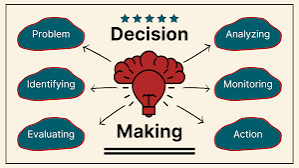Introduction to Decision-Making Systems:
Efficient decision-making is crucial for any business, but without structure, it can become time-consuming and inconsistent. Here's how to establish systems that streamline decision-making:
1. Define Decision-Making Protocols:
Actionable Step: Create a Decision Matrix:
Criteria: List out the criteria for decisions (e.g., cost, impact, time, resources).
Weight: Assign weights to each criterion based on importance.
Options: Evaluate each option against these criteria to make data-driven decisions.
Actionable Step: Set Decision Thresholds:
Delegation: Determine at what level decisions can be made without escalating (e.g., expenses up to $500 can be approved by department heads).
Escalation: Define when decisions need to go up the chain for approval.
2. Implement Decision Trees:
Actionable Step: Map Out Decision Paths:
Flowcharts: Use flowcharts to visually represent decision paths for complex scenarios. Each node represents a decision point with possible outcomes leading to further decisions or actions.
Software: Tools like Lucidchart or Miro can help create and share these decision trees.
3. Regular Decision-Making Meetings:
Actionable Step: Schedule Regular Review:
Weekly/Bi-Weekly: Establish regular meetings for decision-making, ensuring all relevant parties are present.
Agenda: Use a standardized agenda where decisions are prioritized, discussed, and recorded.
4. Data-Driven Decision Making:
Actionable Step: Collect and Analyze Data:
Dashboards: Use tools like Tableau or Google Data Studio to have real-time data at your fingertips for informed decisions.
A/B Testing: For marketing or product decisions, implement A/B testing to gather empirical evidence on what works best.
5. Decision Documentation:
Actionable Step: Record Decisions:
Decision Log: Keep a log of decisions made, including rationale, who made the decision, and outcomes. This helps in learning from past decisions and maintaining consistency.
Post-Decision Review: After a decision has been implemented, review its effects to learn and refine the decision-making process.
6. Empowerment Through Systems:
Actionable Step: Train Your Team:
Decision Rights: Clearly define who can make what decisions, empowering staff to act within their domain.
Training: Provide training on how to use the decision-making systems, ensuring everyone understands the process.
7. Streamline with Technology:
Actionable Step: Leverage Software:
Project Management Tools: Use Asana or Trello for tracking decisions related to projects.
Voting or Polling Tools: For quick consensus, tools like Slack polls can help gather team input on less critical decisions.
8. Feedback Loops:
Actionable Step: Establish Feedback Mechanisms:
After-Action Reviews: After decisions are implemented, hold sessions to discuss what was learned.
Continuous Improvement: Use feedback to tweak decision-making systems for better outcomes.
Case Study:
Example: A tech startup implemented a decision matrix for product feature prioritization. They set up criteria like user impact, development cost, and strategic alignment. Decisions were made in weekly sprint meetings, documented in a shared wiki, and reviewed quarterly. This led to more strategic product development and less time spent in endless discussions.
Decision-making systems are about creating a repeatable, efficient framework that aligns with your business's goals and culture. By implementing these systems, you reduce decision paralysis, ensure consistency, and empower your team. Remember, the aim is not to remove human judgment but to enhance it with structure and data. As we continue through this series, consider how these systems can be adapted to your unique business needs.
Make sure to go back to Day 1 to follow through on this entire process. Visit the Newsletter homepage and head over to the tab “From Hands On to Hands Off”.



